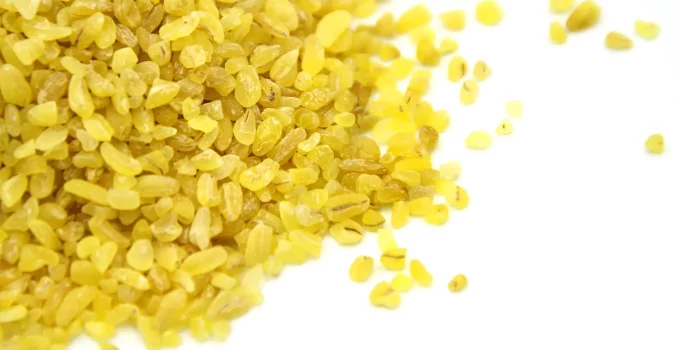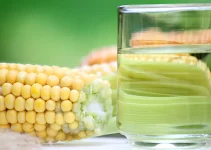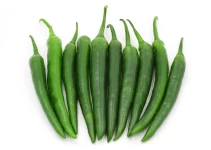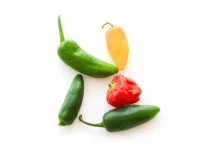I’m well aware that bulgur might not be the most common grain where you live so let’s talk about the best bulgur substitutes in case you can’t get the real deal.
In order to better understand what cereal we’re talking about, I just want to tell you that bulgur looks a lot like couscous, after they’re boiled. For me, these two look very similar.
I mentioned couscous because it has been popular for a lot longer. It will let you make an idea about what kind of grain we’re talking about, although they’re quite different.
Table of Contents
My Favorite Bulgur Substitutes
1. Quinoa: Anthony’s Organic White Whole Grain Quinoa
Given the fact that quinoa is one of the most popular whole grains on the planet, it’s pretty easy to find it. If you need one of the best bulgur substitutes that is also gluten-free and easy to cook, quinoa can be a wonderful option.
2. Brown rice: Nishiki Premium Brown Rice
Although the cooking time for brown rice is around 45 minutes, it’s a delicious and gluten-free bulgur substitute that a lot of people can learn to love. You can also buy a rice cooker for brown rice.
3. Couscous: Bobs Red Mill Couscous Pearl Whole Wheat
If you want one of the best bulgur substitutes that actually resembles it, try couscous. It’s delicious, easy to prepare, pretty affordable and quite readily available even in smaller stores around the world.
4. Bulgur: Nap Boule Ble Bulgur Wheat
If you actually want to try bulgur and give up on searching for the best bulgur substitutes, you should. It’s absolutely delicious.

13 Best Bulgur Substitutes
Each of these substitutes work on a 1:1 replacement. It means that you’ll be using 1 cup of whatever substitute you choose for 1 cup bulgur wheat.
1. Quinoa (famous bulgur gluten-free substitute)
Do I actually need to say something about quinoa? It’s the star of whole grains and has been a celebrity for a long time now.
Since it’s so popular, quinoa might be easier for you to find, either to buy it online or from your local supermarket.
It can be used in the same recipes as bulgur, including for making quinoa tabbouleh.
It even takes about the same time to prepare. Quinoa will take about 15 minutes to cook. They’re quite interchangeable, no matter what you’re trying to cook.
Plus, quinoa is actually gluten-free since it’s a pseudocereal. It’s a seed of the Chenopodium quinoa plant. It’s not a grain.
However, for some, quinoa tastes too much like grass or it’s just too bitter or some feel like it doesn’t have much flavor at all.
In those cases, there are other gluten-free substitutes you can try, like brown rice, orzo, buckwheat, and shelled hemp seeds.
2. Brown rice (delicious & gluten-free)
You can also use white rice but, since we’re talking about nutritious grains, I thought I would recommend using brown rice as one of the best bulgur substitutes.
Check out my reviews for the best rice washer if you decide that you should eat rice more often. It will speed up the whole process.
Brown rice is absolutely delicious and it has a similar nutty flavor so they’re well matched in this respect.
However, it also has to be cooked for longer. It takes about 45 minutes to cook it until it’s tender and good for your dishes. That’s quite a long cooking time but it’s worth it.
Plus, brown rice is a lot easier to find and it’s not extremely expensive, either.
In terms of availability on a global scale, I would name this as my first recommendation.
Now, to answer one important question: can you make brown rice tabbouleh? You absolutely can.
3. Couscous
By now, most of us have heard of couscous. In terms of appearances, this is the substitute that mostly resembles bulgur wheat. It’s also the one with the best name.
However, couscous is a type of pasta that is made from crushed durum wheat semolina.
Thus, it’s neither a grain nor a seed.
Moroccan dishes are especially famous for their use of couscous in combination with lamb, squash, peppers, saffron, ginger, cinnamon, etc. It’s very popular in North Africa.
Most directions on couscous boxes will have you pour boiling water over it and let it sit for 5 minutes. It’s very fast and easy.
If you’re going the traditional route, you’re going to have to steam it. Any couscous can be steamed.
In order to steam it, you need to put it in a colander and then place the colander over a simmering broth of meat and vegetables. You can read more about the whole process here. Thus, it only works if you’re making a broth. Otherwise, just follow the instructions on the packaging.
4. Orzo
Orzo is an awesome substitute for bulgur when you’re making soups. But it can also be used for pasta and for making various salads, tabbouleh included.
Orzo is a rice-like Italian pasta. In Italian, orzo means barley. It was named that way because this tiny pasta has a similar shape to barley grains.
Orzo can be traditionally prepared as pasta because it’s a rice-shaped pasta, made from whole wheat flour, semolina flour or white flour.
It also means that it can be served in the same way as rice. It’s so versatile.
5. Cracked wheat
Cracked wheat is definitely an awesome ingredient, another popular cereal for traditional Mediterranean, North African, and Western dishes. And good for baked goods.
However, there’s one major difference between cracked wheat and bulgur wheat.
Cracked wheat hasn’t been parboiled, it hasn’t been precooked. It’s just raw wheat berries that have been milled into smaller pieces.
However, since the grains are smaller, it’s not going to take longer to prepare to serve as a substitute, especially in salads.
It has to be boiled for 15 to 20 minutes.
6. Farro
Farro is not as popular as the above options but it’s an awesome substitute for bulgur.
It can be used in the same recipes, whether you’re making pilaf, salads, or soups. It won’t get mushy when it’s cooked longer, you won’t have to worry about that.
Farro looks a bit like grains of wheat/wheat berries or similar to barley.
It’s actually an ancient whole-grain wheat so that sounds totally cool.
The trick about cooking farro is that you should soak it in water with a splash of lemon juice/vinegar for several hours or overnight.
After that, you can cook it in the same manner you would cook brown rice. The difference is that it will take about 20 minutes for pearled or semi-pearled farro.
Whole farro will need 40 minutes until it’s tender and chewy.
7. Wheat berries
Wheat berries have a more intense nutty flavor than bulgur. If you’re ready for a more intense taste, you can totally go for wheat berries.
And you can even make tabbouleh with them. So, these grains are also used in the same way as bulgur wheat.
I personally love wheat berries not because they’re supposed to be super nutritious but because they’re delicious in flavor. That chewy texture is delightful, too.
Just like farro, soak them overnight. They’ll cook faster. After that, boil them in the same way as farro for 25 to 40 minutes. It takes a bit longer than it would take to cook bulgur or couscous or quinoa.
Even so, wheat berries are excellent substitutes for rice, quinoa, couscous, and more.
8. Buckwheat (gluten-free)
Buckwheat is another pseudocereal, just like quinoa, despite what its name might indicate. That makes it gluten-free.
It can be used in the same dishes that are made with bulgur, including tabbouleh.
Moreover, it can be pretty easy to find in many places.
It looks like very small seeds of some sort. It’s actually the fruit of a plant that’s related to wild rhubarb.
9. Shelled hemp seeds (gluten-free substitute for bulgur)
If you want to make a gluten-free tabbouleh then you should try it with shelled hemp seeds.
They work so well as a gluten-free substitute and tabbouleh is not the only dish you can make with them. You can use shelled hemp seeds in the same way as you would use bulgur wheat.
Plus, it’s a 1:1 replacement so you don’t have to make any extra calculations.
They’re pretty easy to find and I hope that holds true for the part of the world you live in, too. Their price is a bit expensive but pretty much all options are organic.
10. Freekeh
This is another grain popular in the North African, Easter Mediterranean and West Asian regions.
It’s made from green durum wheat. Freekeh is a grain that’s harvested while still green. Then, the kernels are roasted, dried, and rubbed.
It’s very similar to many of the above grains: wheat berries, farro, bulgur wheat, etc.
However, it has a complex aroma that is a balance between earthy, nutty, and a bit smokey. It would be a delight to experiment with in various recipes, even as one of the best substitutes for bulgur.
It takes about 15 to 20 minutes to cook, which is pretty fast.
11. Kamut
If you’re looking for a grain with a slight sweet taste thanks to its naturally higher sugar contents, then you should look for kamut.
It has a nice buttery, nutty flavor with a bit of sweetness when compared to many of the above grains.
Kamut can replace bulgur in all recipes. It can also work as a replacement for wheat berries, barley, and even corn.
Nevertheless, I should warn you that it’s the ingredient that takes the longest to cook. It takes about 50-60 minutes until it’s done, it needs a bit of patience.
12. Chickpeas
There are plenty of recipes that can be made with chickpeas instead of bulgur.
You might not have expected chickpeas to work as one of the best bulgur substitutes but they certainly do.
They can be used to make falafel, as a substitute in vegetarian chilis, in salads, and many other dishes.
13. Lentils
The same things that I mentioned for chickpeas also apply to lentils. They’re not classic substitutes but both chickpeas and lentils can replace bulgur wheat in certain recipes.
What Is Bulgur?
Let’s quickly establish what bulgur is so that you can understand better how these best bulgur substitutes work. Once you know exactly what this grain is, you’ll know which substitutes work best.
Bulgur wheat is an ancient grain that is a staple in Eastern Mediterranean countries. Turkey, Syria, Jordan, Lebanon, Egypt are countries where this ingredient is a part of most meals consumed throughout the day. It’s as common as rice is for Asian countries.
These nations use this cereal and others like it in hearty soups, pilafs, and salads. It’s not usually used to make bread, although you can do that, too.
Moreover, this is wheat that has been soaked in water, then cooked in steam or under pressure. That’s why it’s so easy to prepare. This is a wheat that has been parboiled, dried, and ground before being packaged for selling.
How is bulgur wheat prepared?
It’s sold in a variety of grinds from fine to extra coarse. It’s milled in three or four sizes: coarse, fine, very fine, and flour. Each will come with its own cooking time and purpose.
Usually, it’s boiled in water for 10 to 15 minutes.
You can also cover the bulgur wheat with boiling water and leave to soak for 20-30 minutes. When the water is absorbed and the grains are tender, it’s time to proceed with the rest of the recipe.
Although it has a chewier texture when it’s soaked in boiling water, it’s a perfect preparation if you’re going to use it in tabbouleh or for salads.
Bulgur is a whole grain, the entire wheat kernel (germ, endosperm and bran) is eaten. That makes it very nutritious and delicious.
However, it also means that it’s not gluten-free. When we’re talking about the best bulgur substitutes, we’ll have to talk about gluten-free replacements as well.
What does bulgur taste like?
The best way to describe what bulgur tastes like is to say that it has a nutty, light flavor and a hearty texture. It’s light in texture and flavor, if we compare it with farro or wheat berries.
It goes well in salads, soups, pilafs, grain bowls, and in baked products.
For us westerners, tabbouleh might be the most easily recognized dish that requires bulgur wheat. For this salad, you’ll need the fine or very fine kind.
As you can see, the amazing thing about this cereal is that it’s very versatile. It can be used as a replacement for couscous, quinoa, brown rice, etc.
The reverse is also true. Couscous, quinoa, brown rice are just a few recommendations for the best bulgur substitutes.
Popular Bulgur Recipes
We have our best bulgur substitutes and you know what bulgur wheat is. Let’s see which are some popular recipes that include it as an ingredients
Basic bulgur
I would say that a basic bulgur recipe needs just 4 ingredients: water, uncooked bulgur, salt, and olive oil.
Technically, we can prepare any other cereal and grain in this way. For this recipe, you can use any of the above substitutes and cook them the same way.
Just pay attention to cooking time and water need for boiling the grain/cereal. And pick the gluten-free ones if that’s your diet.
Tabbouleh
Once again, I will say that any of the above best bulgur substitutes can be used to make tabbouleh.
Bulgur is the classic ingredient but you can adapt that recipe by using buckwheat, brown rice, quinoa, couscous, shelled hemp seeds, wheat berries and anything else you might like.
Any other salad made with bulgur can benefit from the same wide array of substitutes.
Bulgur falafel wrap
If you can’t make a bulgur falafel wrap, make the usual recipe, which is made with chickpeas. Or use fava beans if you have access to them. Or both.
Chickpeas can also be used to make falafel.
Vegetarian chili with bulgur wheat
You can use a combination of chickpeas and beans. Or make chili with lentils.
Another option to try is a Moroccan-style vegetable chili with couscous. There are a lot of variations for vegetarian chilis.
Bulgur stuffed peppers
You can make stuffed peppers with a variety of ingredients. You can use a combination of meat and rice.
If you’re making a vegan or vegetarian stuffed peppers recipe, you can use just rice with vegetables, both white and brown rice can be used.
The peppers can also be stuffed with all the other grains you can find where you live: quinoa, couscous, shelled hemp seeds, wheat berries, farro, orzo (which is an Italian pasta type), etc.
All in all, there are many candidates for the best bulgur substitutes but, if you can and you’re not on a gluten-free diet, I recommend trying the actual grain, just to see for yourself how delicious it is.




